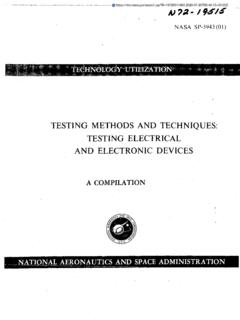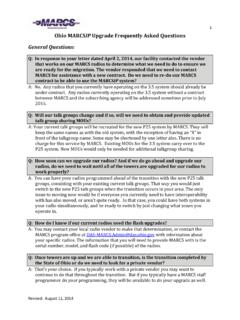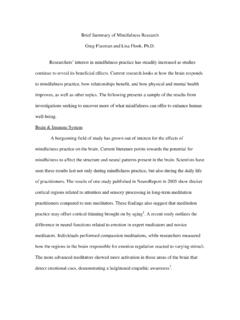Transcription of Responding to Mechanical Antigravity - NASA
1 Marc G. MillisGlenn Research Center, Cleveland, OhioNicholas E. ThomasUniversity of Miami, Miami, FloridaResponding to Mechanical AntigravityNASA/TM 2006-214390 December 2006 AIAA 2006 4913 2020-07-13T03:16:36+00:00 ZNASA STI Program .. in ProfileSince its founding, NASA has been dedicated to theadvancement of aeronautics and space science. TheNASA Scientific and Technical Information (STI)program plays a key part in helping NASA maintainthis important NASA STI Program operates under the auspicesof the Agency Chief Information Officer. It collects,organizes, provides for archiving, and disseminatesNASA s STI. The NASA STI program provides accessto the NASA Aeronautics and Space Database and itspublic interface, the NASA Technical Reports Server,thus providing one of the largest collections ofaeronautical and space science STI in the are published in both non-NASA channels andby NASA in the NASA STI Report Series, whichincludes the following report types: TECHNICAL PUBLICATION.
2 Reports ofcompleted research or a major significant phaseof research that present the results of NASA programs and include extensive data or theoreticalanalysis. Includes compilations of significantscientific and technical data and informationdeemed to be of continuing reference counterpart of peer-reviewed formalprofessional papers but has less stringentlimitations on manuscript length and extent ofgraphic presentations. TECHNICAL MEMORANDUM. Scientificand technical findings that are preliminary orof specialized interest, , quick releasereports, working papers, and bibliographies thatcontain minimal annotation. Does not containextensive analysis. CONTRACTOR REPORT. Scientific andtechnical findings by NASA-sponsoredcontractors and grantees. CONFERENCE PUBLICATION. Collectedpapers from scientific and technicalconferences, symposia, seminars, or othermeetings sponsored or cosponsored by NASA. SPECIAL PUBLICATION.
3 Scientific,technical, or historical information fromNASA programs, projects, and missions, oftenconcerned with subjects having substantialpublic interest. TECHNICAL TRANSLATION. English-language translations of foreign scientific andtechnical material pertinent to NASA s services also include creating customthesauri, building customized databases, organizingand publishing research more information about the NASA STIprogram, see the following: Access the NASA STI program home page E-mail your question via the Internet Fax your question to the NASA STI Help Deskat 301 621 0134 Telephone the NASA STI Help Desk at301 621 0390 Write to: NASA STI Help Desk NASA Center for AeroSpace Information 7115 Standard Drive Hanover, MD 21076 1320 National Aeronautics andSpace AdministrationGlenn Research CenterCleveland, Ohio 44135 Prepared for the42nd Joint Propulsion Conference and Exhibitcosponsored by the AIAA, ASME, SAE, and ASEES acramento, California, July 9 12, 2006 Marc G.
4 MillisGlenn Research Center, Cleveland, OhioNicholas E. ThomasUniversity of Miami, Miami, FloridaResponding to Mechanical AntigravityNASA/TM 2006-214390 December 2006 AIAA 2006 4913 Available fromNASA Center for Aerospace Information7115 Standard DriveHanover, MD 21076 1320 National Technical Information Service5285 Port Royal RoadSpringfield, VA 22161 Available electronically at names and trademarks are used in this report for identificationonly. Their usage does not constitute an official endorsement,either expressed or implied, by the National Aeronautics andSpace work was sponsored by the Fundamental Aeronautics Programat the NASA Glenn Research of Review: This material has been technically reviewed by technical 2006-214390 1 Responding to Mechanical Antigravity Marc G. Millis National Aeronautics and Space Administration Glenn Research Center Cleveland, Ohio 44135 Nicholas E.
5 Thomas University of Miami Miami, Florida 33124 Abstract Based on the experiences of the NASA Breakthrough Propulsion Physics Project, suggestions are offered for constructively Responding to proposals that purport breakthrough propulsion using Mechanical devices. Because of the relatively large number of unsolicited submissions received (about 1 per workday) and because many of these involve similar concepts, this report is offered to help the would-be submitters make genuine progress as well as to help reviewers respond to such submissions. Devices that use oscillating masses or gyroscope falsely appear to create net thrust through differential friction or by misinterpreting torques as linear forces. To cover both the possibility of an errant claim and a genuine discovery, reviews should require that submitters meet minimal thresholds of proof before engaging in further correspondence; such as achieving sustained deflection of a level-platform pendulum in the case of Mechanical thrusters.
6 Nomenclature BPP Breakthrough Propulsion Physics dl Increment of length (m) dt Increment of time (s) F Force (N) f frequency (Hz) g gravitational acceleration ( m/s2) I Impulse (N-s) l length (m) m mass (kg) t duration time (s) deflection angle (radians) Introduction From 1996 to 2002, NASA sponsored research into Breakthrough Propulsion Physics (BPP) that produced 14 peer-reviewed articles (ref. 1). A summary of these findings and research by others indicates that this is a nascent topic encompassing many differing approaches and challenges (ref. 2). Because of the provocative nature of seeking breakthroughs, this work receives much media attention, being cited in Newsweek (ref. 3), Wired (ref. 4), the cover of Popular Science (ref. 5), New York Times (ref. 6), The Boston Globe (ref.)
7 7), and in the books Centauri Dreams (ref. 8), and in I m Working On That (ref. 9); as just some prominent examples. NASA/TM 2006-214390 2 As a consequence of the media exposure, the NASA BPP Project became overwhelmed with submissions from amateur enthusiasts wishing to contribute their ideas (ref. 7). To quantify this situation, statistics were compiled during 2000 through 2001 on all unsolicited correspondence sent into the NASA Project. The findings are presented in table I. Roughly a third of the submissions were from amateurs requesting reviews or other support for their ideas. TABLE I. UNSOLICITED CORRESPONDENCE STATISTICS FROM THE NASA BREAKTHROUGH PROPULSION PHYSICS PROJECT Percent 1000 Unsolicited submissions per year (2000 2001) 100 Professional researchers: News of recent peer-reviewed publications Inquiries about future research solicitations Employment inquires 32 Amateur researchers requesting feedback Here is my Please evaluate my Please help me advance my (About a third of amateur requests, 9% of all submissions, display paranoia or delusions of grandeur) 31 Public inquiries: Please tell me more What is your assessment Please help me with my homework.
8 30 Invitations to conferences/workshops 4 Press interview requests 2 Public speaking requests 1 Given that an objective review and response can take roughly 3 days to prepare and considering the rate of incoming submissions, it is estimated that a fulltime staff of 3 to 4 researchers would be needed just to respond to the amateur requests. In addition to the technical issues, amateur submissions often present the additional challenge of non-professional, emotionally-charged correspondence. Even though reviews were occasionally conducted early in the BPP Project, eventually the Project had to adopt the policy of not reviewing any unsolicited submissions. Other organizations also face the challenge of receiving amateur submissions, but there are no reference-able documents to help guide reviewers on how best to respond. As a service to other reviewers and would-be submitters, the lessons from the BPP Project are summarized here.
9 The quintessential example chosen for illustrating this situation is the common proposal to use oscillating masses or gyroscopes to produce net thrust. Known to violate conservation of momentum when interpreted as a breakthrough claim, such ideas are often summarily dismissed a response that does little to educate or dissuade the submitters. To offer a more effective response, explanations are offered next on why these devices appear to be breakthroughs, how they operate from the perspective of established physics, and what the submitters can do to provide more convincing evidence of how the device really operates. In addition, suggestions are offered on how to phrase the response to encourage the submitters to become more rigorous with their investigations so that they can learn from their experiences. NASA/TM 2006-214390 3 Oscillation Thrusters The oscillation thruster, also describable as a sticktion drive, internal drive, or slip-stick drive, is a commonly suggested device that uses the motion of internal masses to create net thrust.
10 One of the most famous oscillation thrusters is the 1959 Dean Drive described in Patent 2,886,976 (ref. 10). A more recent and simple example is shown in figure 1 (ref. 11). Further still, figure 2 displays an example that uses rotating masses (ref. 12). Although there are many versions, all oscillation thrusters have the following common components: Chassis to support a system of masses Conveyor that moves the masses through an asymmetric cycle Power source for the conveyor A crucial feature is that the internal masses go through a cyclic motion where the motion in one direction is quicker than in the other. The result is that the whole device moves in surges across the ground, giving the appearance that a net thrust is being produced without expelling a reaction mass or having a direct driving connection to the ground. Because it would constitute a breakthrough to be able to move a vehicle without using a reaction mass (ref.)



















